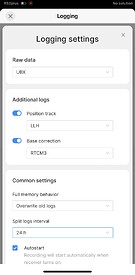I want to try out the OPUS beta on my RS2 and instead of experimenting with the settings in Emlid Flow, I thought I’d check with others first.
My thought is under base settings tab, to hit the Custom tab and check GPS, Glonass, and Galileo and basically leave everything else the same…
I’ve personally used the OPUS beta by recording all constellations at 5hz on the receiver and then using Emlid Studio to refine a file for use in OPUS. You can select which constellations, the rate, and apply time rounding which is supposed to be required in OPUS.
Hi Beartow,
I tested the OPUS beta a while ago, and it does consider all constellations. Since it’s still in beta, we haven’t updated our preset yet.
Yes, you’ll need to tweak the Logging settings—OPUS needs a 30-second interval to process the file properly.
Another option is to log in UBX format with full GNSS rate and all constellations enabled, then adjust it for OPUS in Emlid Studio.
“OPUS beta…GPS, Glonass, and Galileo”
If one is wanting the nearest CORS, each CORS used should be verified as to which constellations are being used, and their IDs must be manually inserted when submitting a file.
.
Earlier posts here suggested a pseudo result might happen if additional constellations were recorded when a CORS station did not track them. Maybe the Beta program has sorted out this issue since then.
I’ve used OPUS Beta for multiple projects and have obtained great results from my RS2s.
As others have mentioned, I’ll collect all constellations/observations in a UBX file for as long as I can because I want a large position pool and I know OPUS will ignore everything between 30-second intervals.
Before I submit, however, I’ll use Emlid Studio to manage my RINEX file size (OPUS has an upper limit) and enforce integer seconds (also required by OPUS). I often pre-subsample down to a 10-second interval and filter satellites with brief observation periods and a lot of noise/cycle slips (usually the ones that were very low on my local horizon). If you already know your closest 4 or 5 CORS and which constellations they are not observing, then you could filter further accordingly.
OPUS will ignore any antenna height offset that you have in the RINEX file header, so make sure you specify the antenna parameters in accordance with how you set up Emlid Flow during your observation.
The only bad luck I’ve had with OPUS Beta is when I tried to specify the CORS I wanted it to use.
Thank you all for the input. Haven’t really used Emlid Studio at all, but may have to for the Beta version





